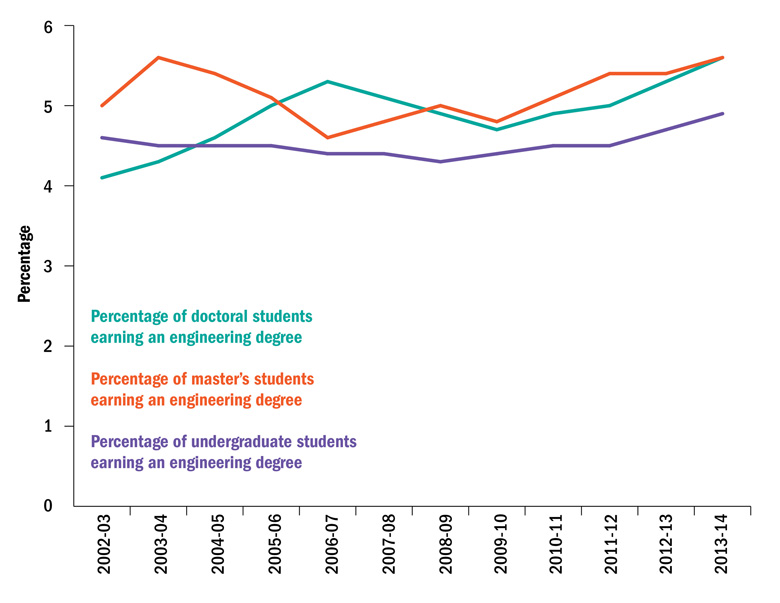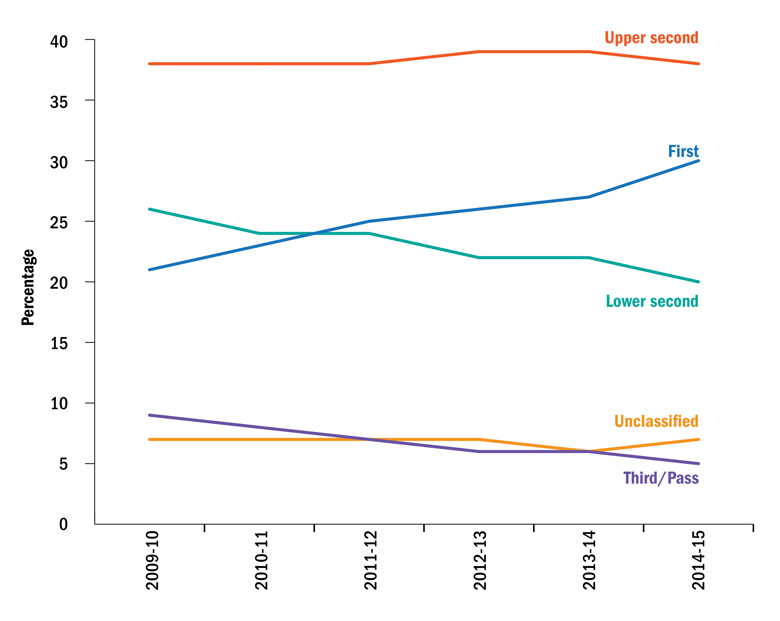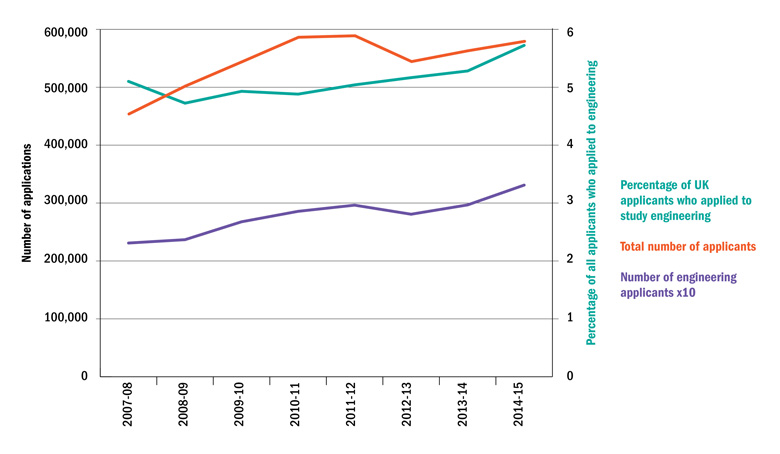Engineering is still something of a dirty word in certain Western countries. The UK is a good example. As a sector of the economy, engineering accounts for £1.2 trillion of turnover, 27 per cent of GDP and at least 3.6 million jobs. Despite this, engineering remains relatively unpopular with students. Applications to study it account for about 5 per cent of all university applications, and the figure is not increasing significantly (see graph, below). The discipline remains particularly unpopular with female students, who make up only about 12 per cent of UK engineering graduates.
Part of the problem is that engineering is widely misunderstood by the public, who equate it with fixing washing machines, servicing cars and driving trains. In fact, of course, technicians, mechanics and drivers respectively do those jobs, but since engineering is not usually studied formally at school, those without family connections have no introduction to the worlds of the civil, mechanical, chemical or electrical and electronic engineer. They are even less likely to be aware of the contribution to society of materials engineers, bioengineers or software engineers. We therefore need to make the point that engineering is a vast, and vastly important, part of society.
Put at its simplest, engineers create, design and make useful stuff. “Stuff” includes almost everything you see around you, almost everything you use and almost every process that results in something useful. Even more fundamentally, engineering is a set of habits of mind, as set out in the Royal Academy of Engineering’s 2014 report Thinking Like an Engineer – Implications for the Education System. These attitudes transcend the technical details of each subdiscipline (thermodynamics, structural analysis, electronic circuit theory or whatever). They consider engineering as a process, not the acquisition of a body of knowledge. And there are some signs that a few universities – in the UK and elsewhere – are trying to change the engineering stereotype, recognising that the subject is about creativity, design and innovation, and includes such diverse disciplines as ethics, rhetoric, finance and management.
In the UK, University College London has embarked on an “integrated engineering programme”, the essence of which is the integration of engineering with the world around us. The programme – which, for the moment, focuses on first-year students – shares with most of the innovative engineering programmes across the world a recognition that engineers operate in a holistic society, in which their skills can be usefully deployed only with the consent of politicians, financiers, ethicists and protesters (see ‘Political engineering’ box, below).
Elsewhere in the world, major innovation has been introduced into engineering curricula. In rough historical order, these include Aalborg University in Denmark, with its focus on problem-based learning since 1974; Olin College of Engineering in Massachusetts, founded in 1997, with experience-led learning and almost no lectures; the iFoundry at the University of Illinois at Urbana-Champaign, a cross-disciplinary experiment begun in 2008 (see ‘The iFoundry’ box, below); Lassonde School of Engineering in Toronto, set up in 2012 with the aim of educating “Renaissance engineers” (see ‘The Lassonde School of Engineering’ box, below); and, also established in 2012, the Singapore University of Technology and Design, which focuses its entire curriculum on design. These initiatives share a number of exciting features, such as active learning, team-working, a high staff-to-student ratio and an undergraduate body that is close to 50 per cent female.
Proportion of US students earning engineering degrees
Source: US Department of Education, National Center for Education Statistics
A fresh initiative in the UK, provisionally called the New Model in Technology and Engineering, aims to learn from these and other international examples and offer programmes in “liberal engineering”. Among the key features of the Hereford-based institution, on whose development we are advising, are a commitment to gender parity, competency-based assessments in place of traditional exams, real-world, problem-based learning taught in a consolidated block schedule and a high-quality blended curriculum featuring a mix of engineering and core business and humanities topics.
But it is not enough for such initiatives to be confined to a few institutions. Major engineering educators across the world should look at the international exemplars and ask themselves some hard questions. We set out a dozen of them below.
1. How are the world’s great challenges going to be solved without engineers who understand and empathise with them?
Among the most obvious issues that humanity faces are securing future supplies of energy (fossil, nuclear, wind or solar? Transmitted via pylons or buried cables – or locally generated?) and clean water (cleaned how? Whose water? Delivered how?). Engineers are essential to the solutions, but they cannot act alone. They need to be trained to convince the rest of society of the efficacy of those solutions; not only the general public but also politicians, businessmen and civil servants too.
2. Why is engineering often erroneously referred to, in universities and beyond, as “applied science”?
Engineers have to communicate fluently in English, but no one calls engineering “applied English”. This off-putting nomenclature arises from the widespread misperception of the nature and history of engineering. Rarely does an engineer spot a new bit of science and immediately invent a device to apply it and make money out of it. More frequently, the engineer spots a societal need and strives to meet it in the most economical and sustainable way possible. To give a couple of rather unsubtle examples: Watt and Boulton did not wait for the development of scientific thermodynamics in order to invent, make and use steam engines, and the Wright Brothers did not wait for aerodynamic equations before developing powered flight.
3. Why is mathematics mandatory for entrance to an undergraduate programme?
Enquiries among our engineer colleagues reveal that most practising engineers use maths engines or modelling software, or even tables of parameters, but few contribute to the development of such mathematically based tools. We would argue that although a minority of engineering graduates should be very competent mathematicians, the vast majority merely need to be comfortable with mathematical concepts and capable of making order-of-magnitude estimates.
4. Engineers work in teams most of the time, so why do they not learn in teams?
Many engineering departments have come to terms with this situation and team and group working have become more common, but many are still wary of the difficult problems associated with assessing the contribution of an individual to a team effort and facing up to the difference between cooperation and plagiarism.
Trends in UK engineering degree classifications
Source: Higher Education Statistics Agency (HESA)
5. Why does engineering attract so few women, and does this matter?
We believe that it does matter because, at a time when we need more engineers, we are failing to tap into 40 per cent of our intellectual capital. We can only speculate about the reasons why engineering is so predominantly male – perhaps because it is largely sold in terms of “boys’ toys” (aeroplanes and fast cars) or massive infrastructure (tunnels and bridges). But if the pioneering engineering programmes mentioned above can be as attractive to women as to men by taking a wider view, then other departments can learn from their example.
6. What is the function of lectures?
Active learning – in the form of problem-based, project-based or experiential learning – is known to be so much more effective for developing understanding than memorisation: the end to which lectures have traditionally been the means. We probably all agree that we would prefer our aeroplanes or water-treatment plants to be designed by engineers who understand why and how they work, rather than by those who have memorised the correct formula but don’t know what it means. The only credible function for a lecture is to inspire students, but unfortunately most of them don’t. It is also bizarre (but common) to hear university programmes being discussed or even ranked according to the number of hours devoted to lectures. Surely this should be an inverse measure – the fewer lectures the better.
7. Why does an adult learner need 22 weeks off per year, when a young person in employment gets only six?
This question goes beyond engineering, of course, but, aside from long-standing tradition, we can find few reasons for it. We don’t buy the arguments asserting that students need “assimilation time”. In our experience, long vacations more closely resemble “forgetting” time.
8. What is wrong with constructively failing at a task?
The making of mistakes is an essential aspect of an effective education, provided it is not discouragingly labelled “failure”. This is a trite and old-school argument, but you would not be impressed by a racing driver who had never spun her car off the road. How could she know where the limits were if she hadn’t? The trick, in engineering schools as elsewhere, is to make sure that students learn from their mistakes when carrying out projects and assignments. After all, Einstein is alleged to have defined insanity as “doing the same thing over and over again and expecting different results”.
9. Why don’t we focus our educative efforts on the students who don’t go on to a PhD?
In the UK, only 4 per cent do so, but research is ridiculously dominant in university staffing policies. Research-driven staff need research-ready and research-inspired postgraduate students. So this is the direction that undergraduate education takes.
UK domiciled applications to undergraduate engineering
Source: Higher Education Statistics Agency (HESA)
10. Why do engineering graduates find it so difficult to demonstrate their abilities to employers?
More than 70 per cent of UK engineering graduates now get a “good honours” degree, but what use is such terminology to a recruiter? It would be much better for a graduate to present a portfolio of real achievements, together with an explanation of their own tried-and-tested working style. In engineering, this is quite feasible: we would expect a student who has been learning actively to have accumulated a dozen or more examples of achievements, such as things they have made, designs they have developed, processes they have invented or even teams they have led. None of these is evidenced by the outcome of a written exam.
11. How are engineers to be future-proofed?
A graduate engineer of 2020 will probably want and need to work for more than 50 years. In our view, we cannot predict what engineering topics will dominate the world even in 10 years’ time, but we can be very confident about two things: that the macroscopic laws of physics will still apply and that no student will complete an engineering programme unless her interest is piqued and stimulated. The first tells us that an engineering programme must contain some fundamental content that will not change over time. The second tells us that if we do not provide currently relevant and exciting examples of the application of engineering, we won’t have any students to teach. The crucial question is how to balance timeless fundamentals with timely excitement.
In our view, the difficulty of reflecting on these issues and acting on the conclusions stems from the innate conservatism of many staff, together with the scarcity of champions for educational change. But as Samuel Johnson said: “Nothing will ever be attempted if all possible objections must first be overcome.”
For our part, we have been lucky to be involved in an innovative project in which our ideas for change have been welcomed – indeed embraced. The New Model, due to open in 2019, is planning to establish professional engineering as a humanitarian pursuit, designed to attract both women and men to its staff and student bodies. The liberal engineering programme will involve much project work, very few lectures and a 46-week year, with students taking part in 20 or more projects from industry. They will graduate with an MEng after three years (instead of the standard four), with a portfolio of achievements, a positive attitude towards society and world challenges and an ability to help change the status quo.
They will also be numerate enough to spot that we mentioned a dozen questions, only listed 11 and actually asked 13. But they will be sensible enough to realise that this does not matter!
Peter Goodhew is a former dean of engineering at the University of Liverpool and is author of Teaching Engineering (Royal Academy of Engineering, 2014). Kel Fidler was formerly vice-chancellor of Northumbria University and chair of the UK Engineering Council.
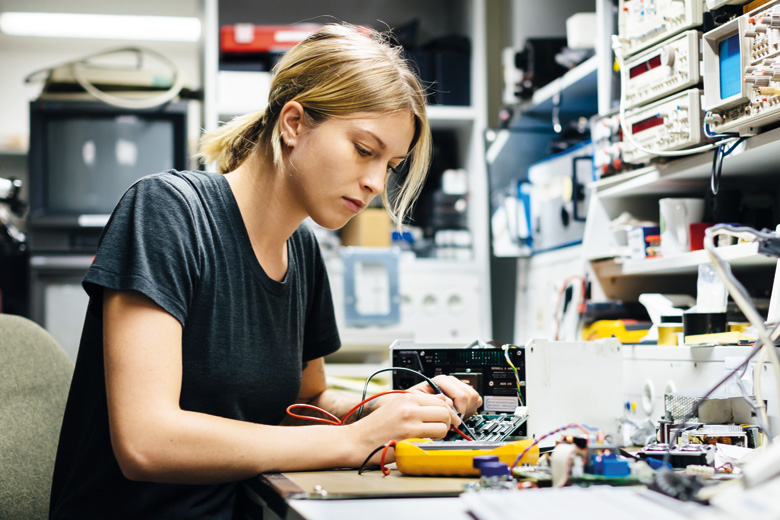
Bringing women back into the fold
In recent years, there has been a noticeable push in many developed nations for more girls to study maths and science at school in order to broaden their representation in fields such as engineering. Yet these efforts are not as fruitful as many believe. In fact, the young women who are successfully attracted to engineering are leaving the field faster than their male counterparts.
Our longitudinal study followed 700 students during their four years of study at four schools: the Massachusetts Institute of Technology, the University of Massachusetts, Olin College of Engineering in Needham, Massachusetts, and the women-only Picker Engineering Programme at Smith College in Northampton, Massachusetts. We also followed up with them five years after they graduated. By examining their voluntary diary entries and focusing on their personal interactions, college culture and future occupational and family expectations, we pieced together a coherent picture of what is causing these women to leave engineering behind.
Factors such as unchallenging projects, sexual harassment and greater isolation from support networks are significant contributory factors. Many of the women reported witnessing blatant gender bias in their project teams and internships, with many of the typically “hands-on” roles often being reserved for men: women were more likely to be given more secretarial-type duties.
Another important factor is that women, much more than men, cite engineering’s potential for social development as a key factor of interest, and often even a motivation for their working in the sector. Yet our study showed that their experiences within internships and undergraduate programmes had seen only lip service paid to the notion of improving society. The impact this had on their morale was substantial and was a factor for many in their choice to change career path. More must be done outside the classroom to tackle these attitudes and bring the top female talent back into the fold.
Brian Rubineau is associate professor of organisational behaviour at McGill University, Canada.
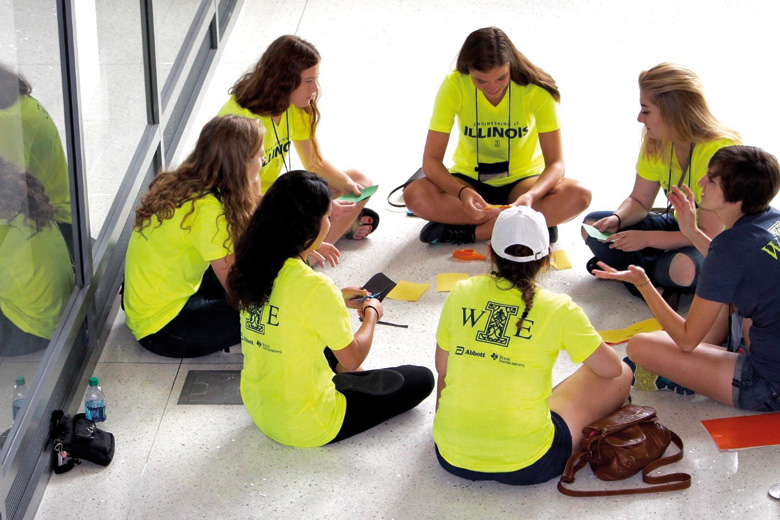
The iFoundry
Change is difficult in higher education. Culture is entrenched, and inertia is real. This is only more true in engineering, given that many of the world’s most productive and influential programmes are part of large, state-supported public universities.
The University of Illinois at Urbana-Champaign and Georgia Tech, for example, each produce more world-class engineering undergraduates than Stanford University, the Massachusetts Institute of Technology and the California Institute of Technology combined. Our size gives those of us at these schools a special responsibility to take education just as seriously as we take research, and to constantly refine our educational practices for a changing world.
With this in mind, my colleagues and I launched iFoundry at Illinois in 2007. Now part of our broader Academy for Excellence in Engineering Education (AE3), the Illinois Foundry for Innovation in Engineering Education is a crossdisciplinary curriculum incubator, aimed at enhancing our students’ educations and sharing those innovations with the world.
Our faculty pioneer rigorous, data-driven teaching techniques focused on engaging students in unique ways. AE3’s Strategic Instructional Innovations Program enables teams of faculty to prototype new methodologies and learning technologies in targeted courses, chosen annually through a competitive proposal process. Having the intellectual space to explore and test those techniques is indispensable since we are committed to only making changes to our programmes after they have been thoroughly piloted and refined in light of constant feedback.
The Illinois Engineering First-Year Experience is our greatest success to date. The programme makes it clear from day one that students’ own passions, goals and ideas will be at the heart of their time here. All engineering freshmen at Illinois – about 1,500 per year – participate. It includes a course focused on what it means to be an engineer, led by our most outstanding advanced undergraduate students. It also includes elective courses that are updated annually to reflect student interests, such as international development, sustainability or product design. Co-curricular educational programmes, such as a series of “corporate connections” lunches, run throughout the year, encouraging freshmen to expand their conceptions of what an engineer can do.
Our new degree programme in innovation, leadership and engineering entrepreneurship, which students undertake alongside a degree in a traditional engineering discipline, is a result of this same attitude towards rigorous testing and constant improvement. It grew out of our Technology Entrepreneur Center, where more than 1,000 students take a course every year. Nothing has been more clearly student-driven in recent years than our focus on entrepreneurship and leadership. Students expect it, and we are thrilled to deliver it.
Changes in engineering education are not only possible, they are absolutely required. The world moves too quickly to think otherwise.
Andreas Cangellaris is dean of the University of Illinois at Urbana-Champaign’s College of Engineering and is M. E. Van Valkenburg professor of electrical and computer engineering.
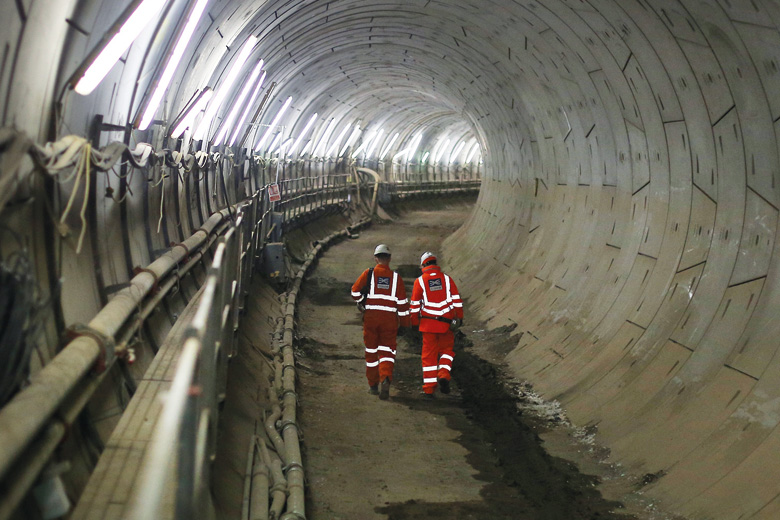
Political engineering
It has been suggested that politics is typically evidence-informed rather than evidence-based. Engineers are taught to develop logical, science-based arguments. This doesn’t necessarily prepare them well for the challenges they will face in their careers.
In the UK, engineering faculties already teach their students many valuable things beyond the strict course content, including employability and the importance of soft skills. However, the art of navigating political environments and stakeholder relations is something that has been lacking.
It’s not an understatement to say that if an engineering project doesn’t have the backing of the right people politically, it is unlikely to get off the ground and will be in a perpetual state of re-engineering and consultation. In my discipline of infrastructure engineering, there have been some recent examples of large-scale UK infrastructure projects that have been affected by this, both positively and negatively. The Crossrail urban railway project in London is an extraordinary achievement for UK engineering. It is Europe’s biggest construction project, yet many Londoners are not even aware of its existence. Engineers, industry and government came together at the right time to solve a complex infrastructure challenge in one of the world’s biggest cities.
On the other side of the coin, expansion of airport capacity in the southeast of England has been stalled in a political quagmire. Expansion of Heathrow Airport was first mooted in 1985 and, over the years, engineers have been asked to assess a wide range of potential solutions. The problem is that although engineers understand the systemic implications of decisions for wider infrastructure, they are not trained to engage with the full range of social and political challenges associated with the various options. Hence, it has been very difficult to persuade the public or the government of the merits of a third runway because of other factors, such as concerns about the number of people who would be affected by disruption during construction, and aircraft noise and pollution thereafter.
Nor are these problems unique to infrastructure engineering. Energy and the disposal of nuclear waste, as well as chemical engineering for the health and pharmaceutical industries, are examples of where we need engineers, government, industry and the public to agree on a solution to very complex problems, and work together to make solutions happen. Such solutions should be multifaceted, deploying a range of technical, economic and social projects and policies that are tuned to create and distribute value across the spectrum of stakeholders. This can be done through policies that promote shared ownership of assets, or community-led projects that reflect the needs and values of that community. Key to such projects is the need to communicate the opportunities in a manner that ensures that each group understands and appreciates this value. The recent wrangling over the UK’s proposed new French-built and Chinese-financed nuclear power station at Hinkley Point is a prime example of a failure to create such a solution.
So engineers need to be able to engage in the right manner across society, understanding people and their politics. But this is not something typically taught as part of degree programmes.
To address this, we have begun asking an interdisciplinary group of third-year undergraduates in our Sheffield Engineering Leadership Academy to work on a complex grand challenge. This year they explored how the UK can create a decarbonised, secure and affordable energy system.
The students adopt a systemic approach, talking to key stakeholders and then mapping the causal relationship between technologies, economics and the wider social systems, such as networks of health, welfare, education and their interrelationships. Although this is an engineering challenge, they quickly realise that to solve it requires them to understand a wide spectrum of people and perspectives. The aim is to deliver a short report of their findings and proposals to target relevant policymakers.
Engineering is far more than just applied science. Whether the challenge is meeting global carbon dioxide targets, addressing the housing shortage or tackling the moral conundrums relating to the emergence of artificial intelligence, there is no global political debate, local policy issue or day-to-day decision that doesn’t involve engineering in some way. The essence of engineering is in its practice, so preparing students for real-world problems in all their complexity is vital.
Martin Mayfield is professor of engineering design, infrastructure leader in the Faculty of Engineering and chair of Sheffield Engineering Leadership Academy at the University of Sheffield.
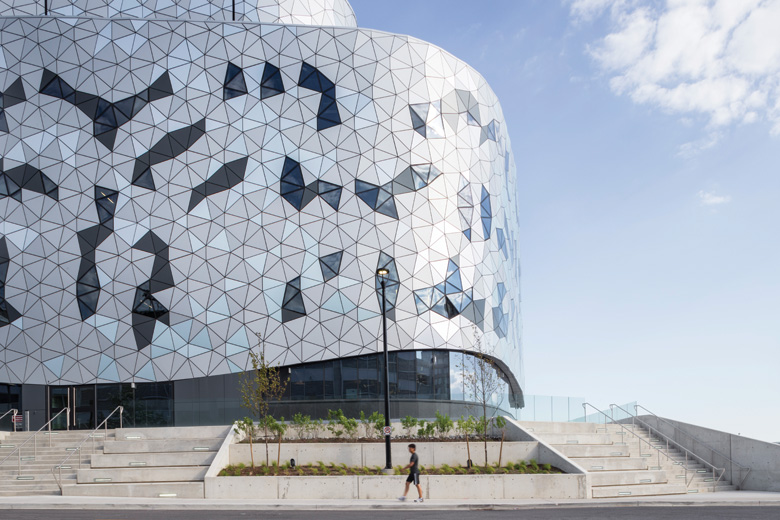
The Lassonde School of Engineering
The world has changed dramatically since the end of the Cold War. Climate change has replaced nuclear annihilation as humanity’s greatest threat.
The millennial generation must take on the complex human challenges of ensuring food security, sustainable energy and universal access to clean water. And they must realise the true potential of driverless vehicles, 3D printing, quantum computing, advanced robotics and artificial intelligence in a future described by the World Economic Forum as the Fourth Industrial Revolution.
Addressing these challenges and possibilities requires teams of diverse talent. Engineers need to be humanists as well as technologists, thinking in big systems, designing with people in mind and considering the long-term consequences of their actions. Yet engineering education continues to turn out lone wolves, well-versed in theoretical concepts and passing exams.
The Lassonde School of Engineering at York University in Toronto, Canada was established a few years ago with this in mind. We are building the home of what we call the Renaissance engineer, which takes engineering education back to the principles on which it was founded, with practice and theory going hand-in-hand.
Working with students and employers, with the creative stimulation of a partnership with Silicon Valley design firm IDEO, we identified three areas of focus to drive change, which are applicable to schools everywhere. Put simply, we need to change what we teach, how we teach it and who we teach it to.
First, we need a broader and richer curriculum that rebalances technical knowledge with hands-on practical learning. At Lassonde, we’ve developed partnerships with the Business School and the Law School at our university to give engineering students the chance to learn concepts such as commercialisation and intellectual property. We’ve also given every student the opportunity to undertake placements in companies, or to start their own firms, as an integrated part of their education.
Second, we need to “flip the classroom” so that students learn course content online through videos and virtual reality, before coming to class to interact with academics and peers on design-based projects. In our brand new C$125 million (£75 million) building, we have zero lecture halls. They have been replaced by flexible classrooms, collaboration spaces, student-run “anarchist labs” – in which students can work on their own passion projects – and even nap rooms. With its wood floors, whiteboard walls and iconic glass and aluminium facade, the space looks and feels more like a start-up headquarters than your typical brutalist engineering building.
Third, and perhaps most importantly, we need to change who we teach. In the past few decades, women have increasingly attained positions of power and influence across our societies, and business and governments have learned that gender diversity in boardrooms and cabinets tends to produce better decision-making. But while law and medical schools are often majority female nowadays, that’s far from the case in engineering, where women still make up less than 20 per cent of the typical undergraduate class. Engineering education is missing out on the race for female talent, and societies are missing the perspective of women to solve problems.
Last, we must give students the confidence to tackle questions that don’t have an answer, rather than simply learning the answers to questions that already have a solution. We need to learn from listening to students rather than lecturing them. Above all, engineering students must think creatively by coding, prototyping and designing a future in which humans and technology are allies, not adversaries.
Janusz Kozinski is founding dean of the Lassonde School of Engineering at York University, Toronto, Canada.
POSTSCRIPT:
Print headline: Building society
Register to continue
Why register?
- Registration is free and only takes a moment
- Once registered, you can read 3 articles a month
- Sign up for our newsletter
Subscribe
Or subscribe for unlimited access to:
- Unlimited access to news, views, insights & reviews
- Digital editions
- Digital access to THE’s university and college rankings analysis
Already registered or a current subscriber?

